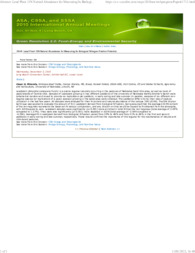Lead plant 15N natural abundance for measuring its biological nitrogen fixation potential.
Lead plant 15N natural abundance for measuring its biological nitrogen fixation potential.
Author(s): MIRANDA, C. H. B.; FOLLET, R.; SCHACHT, W.
Summary: Leadplant (Amorpha canescens Pursh) is a prairie legume naturally occurring in the pastures of Nebraska Sand Hills area, as well as most of pasturelands of Central USA. Samples of Leadplant growing in two different paddocks of the University of Nebraska Bartha Brother's Ranch were collected at random and mixed to provide six replications per paddock, in early spring and late summer. In parallel, samples of six different non-legume species (or replications of a given species) growing in the same area were collected. The paddocks differ only by their rate of pasture utilization in the last few years. All samples were analyzed for their N content and natural abundance of the isotope 15N (d15N). The15N dilution technique was applied to evaluate the amount of N in Leadplant derived from biological N fixation, being assumed that the averaged d15N content of the non-legumes represents the basal soil N isotopic composition, and any dilution on that would be caused by N obtained from the atmosphe, with d15N equals to zero. Leadplant samples were significantly (p<0.001) more enriched in total N than the non-legumes (total average of 2.09% compared to 1.37%). They were also significantly (p<0.001) more depleted in d15N (total average of -2.049 compared to -4.294). Averaged N in Leadplant derived from biological N fixation varied from 39% to 46% and from 51% to 66% in the first and second paddocks in early spring and late summer, respectively. These results confirms the importance of this legume for the maintenance of natural and introduced pastures.
Publication year: 2010
Types of publication: Abstract in annals or event proceedings
Unit: Embrapa Beef Cattle
Keywords: Amorpha canescens Pursh, Fixação de Nitrogênio, Pastagem, Pastures
Observation
Some of Embrapa's publications are published as ePub files. To read them, use or download one of the following free software options to your computer or mobile device. Android: Google Play Books; IOS: iBooks; Windows and Linux: Calibre.
Access other publications
Access the Agricultural Research Database (BDPA) to consult Embrapa's full library collection and records.
Visit Embrapa Bookstore to purchase books and other publications sold by Embrapa.

